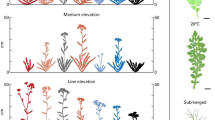Abstract
The relationship between probability of survival and the number of deleterious mutations in the genome is investigated using three different models of highly redundant systems that interact with a threatening environment. Model one is a system that counters a potentially lethal infection; it has multiple identical components that act in sequence and in parallel. Model two has many different overlapping components that provide three-fold coverage of a large number of vital functions. The third model is based on statistical decision theory: an ideal detector, following an optimum decision strategy, makes crucial decisions in an uncertain world. The probability of a fatal error is reduced by a redundant sampling system, but the chance of error rises as the system is impaired by deleterious mutations. In all three cases the survival profile shows a synergistic pattern in that the probability of survival falls slowly and then more rapidly. This is different than the multiplicative or independent survival profile that is often used in mathematical models. It is suggested that a synergistic profile is a property of redundant systems.
Model one is then used to study the conservation of redundancy during sexual and asexual reproduction. A unicellular haploid organism reproducing asexually retains redundancy when the mutation rate is very low (0001 per cell division), but tends to lose high levels of redundancy if the mutation rate is increased (001 to 01 per cell division). If a similar unicellular haploid organism has a sexual phase then redundancy is retained for mutation rates between 0001 and 01 per cell division. The sexual organism outgrows the asexual organism when the above mutation rates apply. If they compete for finite resources the asexual organism will be extinguished. Variants of the sexual organism with increased redundancy will outgrow those with lower levels of redundancy and the sexual process facilitates the evolution of more complex forms. There is a limit to the extent that complexity can be increased by increasing the size of the genome and in asexual organisms this leads to progressive accumulation of mutations with loss of redundancy and eventual extinction. If complexity is increased by using genes in new combinations, the asexual form can reach a stable equilibrium, although it is associated with some loss of redundancy. The sexual form, by comparison, can survive, with retention of redundancy, even if the mutation rate is above one per generation.
The conservation and evolution of redundancy, which is essential for complexity, depends on the sexual process of reproduction.
Similar content being viewed by others
References
Baltimore D 2001 Our genome unveiled;Nature (London) 409 814–816
Banks R E, Dunn M J, Hochstrasser D F, Sanchez J-C, Blackstock W, Pappin D J and Selby P J 2000 Proteomics: new perspectives, new biomedical opportunities;Lancet 356 1749–1756
Bulmer M G 1980The mathematical theory of quantitative genetics (Oxford: Oxford University Press)
Crow J F 1997 The high spontaneous mutation rate: is it a health risk?;Proc. Natl. Acad. Sci. USA 94 8380–8386
Drake J W, Charlesworth B, Charlesworth D and Crow J F 1998 Rates of spontaneous mutation;Genetics 148 1667–1686
Eyre-Walker A and Keightley P D 1999 High genomic deleterious mutation rates in hominoids;Nature (London) 397 344–347
Erickson H P 1993 Gene knockouts of c-src, transforming growth factor beta-1 and tenascin suggests superfluous, non-functional expression of proteins;J. Cell Biol. 120 1079–1081
Gabriel W, Lynch M and Burger R 1993 Muller’s rarchet and mutational meltdown;Evolution 47 1744–1757
Haldane J B S 1937 The effects of variation on fitness;Am. Nat. 71 337–349
Hamilton W D, Axelrod R and Tanese R 1990 Sexual reproduction as an adaptation to resist parasites (a review);Proc. Natl. Acad. Sci. USA 87 3566–3573
Kimura M and Maruyama T 1966 The mutation load with epistatic gene interactions in fitness;Genetics 54 1337–1351
King J L 1966 The gene interaction component of the genetic load;Genetics 53 403–413
Kondrashov A S 1982 Selection against harmful mutations in large sexual and asexual populations;Genet, Res. Camb. 40 325–332
Kondrashov A S 1988 Deleterious mutations and the evolution of sexual reproduction;Nature (London) 336 435–440
Kondrashov A S 1994 Muller’s ratchet under epistatic selection;Genetics 136 1469–1473
Kondrashov A S 2001 Sex and U;Trends Genet. 17 75–77
Krakauer D C and Nowak M A 1999 Evolutionary preservation of redundant duplicated genes;Cell Dev. Biol. 10 555–559
Krakauer D C and Plotkin J B 2002 Redundnacy, antiredundnacy, and the robustness of genomes;Proc. Natl. Acad. Sci. USA 99 1405–1409
Lewin B 1997Genes V1 (Oxford: Oxford University Press)
Lynch M and Gabriel W 1990 Mutational load and the survival of small populations;Evolution 44 1725–1737
Mattick J S 1994 Introns: evolution and function;Curr. Opinion Genet. Dev. 4 823–831
Morris J A 1997 Genetic control of redundant systems;Med. Hypotheses 49 159–164
Morris J A 1999 The kinetics of epithelial cell generation; its relevance to cancer and ageing;J. Theor. Biol. 199 87–95
Morris J A 2001a Information theory: a guide in the investigation of disease;J. Biosci. 26 15–23
Morris J A 2001b How many deleterious mutations are there in the human genome?;Med. Hypotheses 56 646–652
Morris R D, Morris K L and Morris J A 2002 The mathematical basis of sexual attraction;Med. Hypotheses 59 475–481
Muller H J 1950 Our load of mutations;Am. J. Hum. Genet. 2 111–176
Muller H J 1964 The relation of recombination to mutational advance:Mutational advance;Mutat. Res. 1 2–9
Nowak M A, Boerlijst M C, Cooke J and Maynard-Smith J 1997 Evolution of genetic redundnacy;Nature (London) 388 167–171
Oliver S G 1996 From DNA sequence to biological function;Nature (London) 379 597–600
Redfield R J 1994 Male mutation rates and the cost of sex for females;Nature (London) 369 145–147
Simmons M J and Crow J F 1977 Mutations affecting fitness inDrosophila populations;Annu. Rev. Genetics 11 49–78
Tautz D 1992 Redundancies, development and the flow of information;Bioessays 14 263–266
Author information
Authors and Affiliations
Corresponding author
Rights and permissions
About this article
Cite this article
Morris, J.A., Morris, R.D. The conservation of redundancy in genetic systems: effects of sexual and asexual reproduction. J Biosci 28, 671–681 (2003). https://doi.org/10.1007/BF02708427
Received:
Accepted:
Issue Date:
DOI: https://doi.org/10.1007/BF02708427



